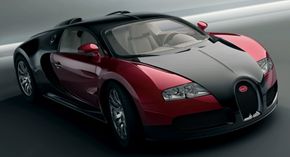How would you define the most amazing production car in the world? Would it be:
- The car with the most horsepower?
- The car with the fastest top speed and acceleration?
- The most expensive car?
At the moment, the Bugatti Veyron appears to have it all:
Advertisement
- A W-16 engine that can produce 1,001 horsepower
- A top speed of 250+ mph (400+ kph)
- A zero-to-60 time of three seconds
- A zero-to-180 time of 14 seconds
- A price tag somewhere in the $1.2 million range.
In this article, we will take an in-depth look at this amazing automobile and see how it is possible to fit so much performance into a single machine. It all starts with the engine...
The Bugatti Veyron is a car built around an engine. Essentially, Bugatti made the decision to blow the doors off the supercar world by creating a 1,000-horsepower engine. Everything else follows from that resolution.
So let's start with the engine. How would you begin the design process for an engine this powerful? If you have read How Car Engines Work, you know that if you want to create a 1,000-horsepower engine, it has to be able to burn enough gasoline to generate 1,000 horsepower. That works out to about 1.33 gallons (5 liters) of gasoline per minute.
We need a 16-liter engine to burn 1.33 gallons of gas per minute. That actually makes sense -- the engine in the Dodge Viper is 8.0 liters in displacement and produces 500 hp.
But there's a problem: A 16-liter V-8 engine would be very large. And the pistons would be massive, so there would be no way it could turn at 6,000 rotations per minute (rpm). It might turn at a maximum of 2,000 rpm, meaning that you would need an immense 48-liter engine to generate 1,000 hp. Clearly an engine that big is impossible in a passenger car.
So how did Bugatti fit 1,000 horsepower into a passenger car? Let's find out.
